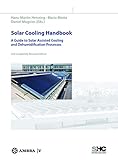Solar cooling handbook : a guide to solar assisted cooling and dehumidification processes / Hans-Martin Henning, Mario Motta, Daniel Mugnier (eds.).
Publisher: Vienna : Ambra V, 2013Edition: Third completely revised editionDescription: 368 pages : illustrations (chiefly colour) ; 28 cmContent type:- text
- unmediated
- volume
- 9783990434383 (hardback.)
- 3990434381 (hardback.)
- Guide to solar assisted cooling and dehumidification processes
- Solar assisted cooling and dehumidification processes
| Item type | Current library | Home library | Collection | Call number | Materials specified | Copy number | Status | Date due | Barcode | |
|---|---|---|---|---|---|---|---|---|---|---|
| AM | PERPUSTAKAAN LINGKUNGAN KEDUA | PERPUSTAKAAN LINGKUNGAN KEDUA KOLEKSI AM-P. LINGKUNGAN KEDUA | - | TH7687.9.S633 2013 3 (Browse shelf(Opens below)) | 1 | Available | 00002122325 |
Includes bibliographical references.
This handbook explores the design of a solar assisted air-conditioning system. It provides an overview of the various solutions used to convert solar heat into useful cooling as well as offers specifics and detailed specifications. Our energy system faces a fundamental transformation and renewable energies will play a dominant role in the future energy supply. One of the promising solutions is the use of solar thermal energy in buildings, for cooling, heating and domestic hot water preparation. Solar thermal systems for providing heat and cold to industrial processes show a high potential, too. In the last decade, the application of solar driven cooling systems achieved a significant progress. Steps forward have been taken in the design of system concepts to specific needs and in more reliable and efficient operation of the installed plants. New systems are available on the market and cover a broad range of cooling capacities and driving temperatures. This handbook provides an overview on the various solutions to convert solar heat into useful cooling, reports about experiences made with realized installations and gives support in the design process. Its use will strongly contribute to achieve high quality solar cooling systems which provide significant energy savings and fulfil the user s requirements in a safe and reliable way.
There are no comments on this title.

